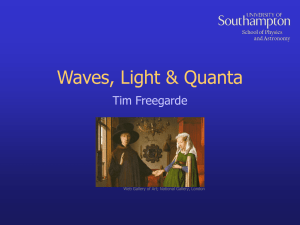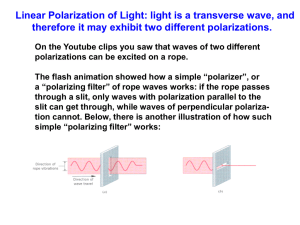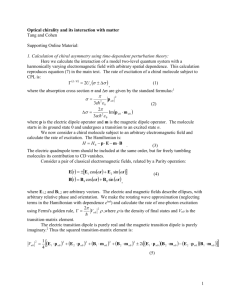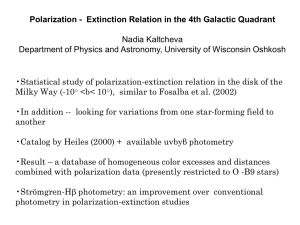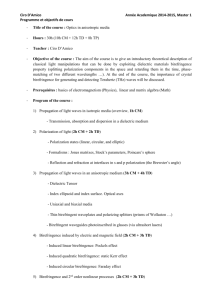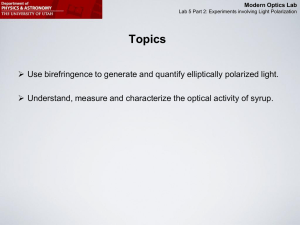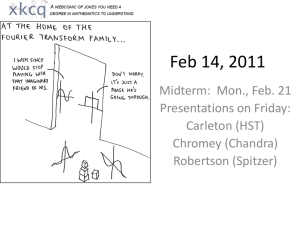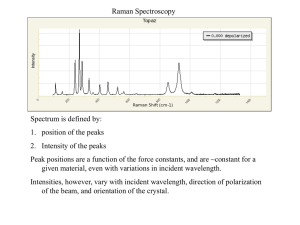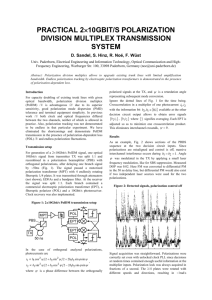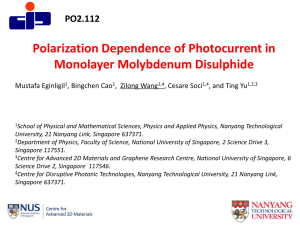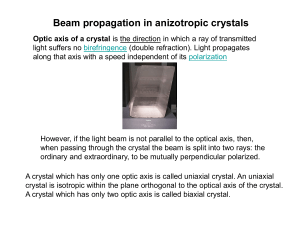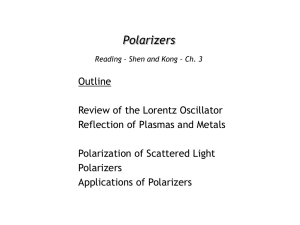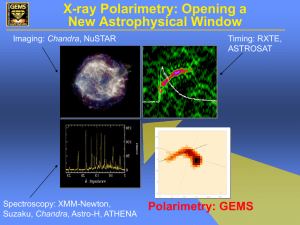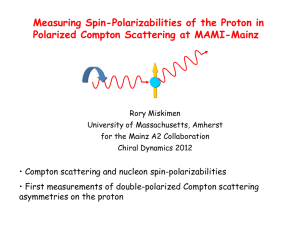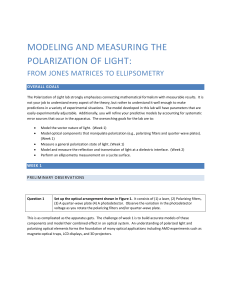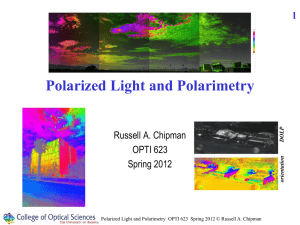Week 4
advertisement
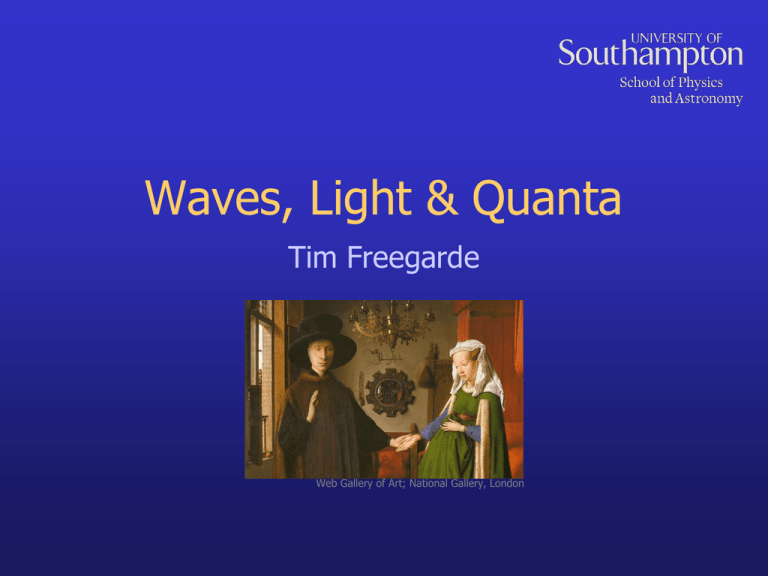
Waves, Light & Quanta Tim Freegarde Web Gallery of Art; National Gallery, London Sinusoidal waves z • simple harmonic motion yx, t r sin t kz • circular motion r, where t kz r cost kz, r sin t kz 2 Sinusoidal waves y t t0 x yx, t y0 sin t kx at t t0 , yx, t0 y0 sin kx t0 y0 sin 2 ~ x t0 2 y0 sin x t0 • wavenumber • spectroscopists’ wavenumber • wavelength k 2 1 ~ 3 Sinusoidal waves y x x0 t yx, t y0 sin t kx at x x0, yx0 , t y0 sin t kx0 • angular frequency y0 sin 2 t kx0 • frequency 2 y0 sin t kx0 • period 2 1 4 Birefringence • asymmetry in crystal structure causes two different refractive indices • opposite polarizations follow different paths through crystal • birefringence, double refraction 5 Optical polarization • light is a transverse wave: E perpendicular to k • for any wavevector, there are two field components • any wave may be written as a superposition of the two polarizations 6 Linear dichroism • conductivity of wire grid depends upon field polarization • electric fields perpendicular to the wires are transmitted • fields parallel to the wires are absorbed WIRE GRID POLARIZER 7 Malus’ law • amplitude transmission cos • intensity transmission cos 2 WIRE GRID POLARIZER 8 Linear dichroism • crystals may similarly show absorption which depends upon linear polarization • absorption also depends upon wavelength • polarization therefore determines crystal colour • pleochroism, dichroism, trichroism TOURMALINE 9 Polarization in nature • the European cuttlefish also has polarization-sensitive vision CUTTLEFISH (sepia officinalis) • … and can change its colour and polarization! MAN’S VIEW CUTTLEFISH VIEW (red = horizontal polarization) 10 Circular dichroism • absorption may also depend upon circular polarization • the scarab beetle has polarizationsensitive vision, which it uses for navigation • the beetle’s own colour depends upon the circular polarization SCARAB BEETLE LEFT CIRCULAR RIGHT CIRCULAR POLARIZED LIGHT POLARIZED LIGHT 11 Optical activity (circular birefringence) • optical activity is birefringence for circular polarizations • an asymmetry between right and left allows opposing circular polarizations to have differing refractive indices • optical activity rotates the polarization plane of linearly polarized light • may be observed in vapours, liquids and solids CH3 CH2 CH3 CH3 CH3 H l-limonene (orange) H CH2 r-limonene (lemon) CHIRAL MOLECULES 12 Categories of optical polarization • linear (plane) polarization • non-equal components in phase • circular polarization • equal components 90° out of phase • elliptical polarization • all other cases 13 Polarizing components LINEAR CIRCULAR POLARIZER (filter/separator) Tx Ty TL TR WAVEPLATE (retarder) x y L R 14 Waveplates (retarders) • at normal incidence, a birefringent material retards one polarization relative to the other • linearly polarized light becomes elliptically polarized 2 0 e l WAVEPLATE 15 Polarization notation • circular polarization • right- or left-handed rotation when looking towards source • traces out opposite (right- or left-) handed thread RCP plane of incidence perpendicular parallel • linear (plane) polarization • parallel or perpendicular to plane of incidence • plane of incidence contains wavevector and normal to surface 16 Polarization by scattering cdoswell.com/tips3.htm 17 Brewster’s angle r i i r • reflected light fully (s-) polarized cos i sin r 1 sin i tan i 18 Brewster’s angle i i r www.paddling.net/sameboat/archives/sameboat496.html r • reflected light fully (s-) polarized tan i 19 Malus’ law • amplitude transmission cos • intensity transmission cos 2 WIRE GRID POLARIZER 20 Characterizing the optical polarization • wavevector insufficient to define electromagnetic wave • we must additionally define the polarization vector a ax , a y • e.g. linear polarization at angle i a cos, esin sin k x z y 21 Jones vector calculus • if the polarization state may be represented by a Jones vector a ax, a y • then the action of an optical element may be described by a matrix ax a11 a12 ax a a a a y 21 22 y JONES MATRIX a11 a12 A a a 21 22 22 Jones vector calculus state may be represented transmission by • if thepolarization Aby 1 a horizontal polarizer Jones vector 1 0 0 0 a a ,a exp i x x 0y retardation by A the action of an optical element • 2then waveplate 0 exp i y may be described by a matrix 11 a12 cosA asin projection onto a A3 rotated axes 21 a22 sin cos ax a11 a12 ax a a a a y 21 22 y JONES MATRIX 23 Birefringence • asymmetry in crystal structure causes two different refractive indices • opposite polarizations follow different paths through crystal • birefringence, double refraction 24 Linear polarizers (analyzers) • birefringence results in different angles of refraction and total internal reflection • many different designs, offering different geometries and acceptance angles o-ray e-ray 38.5º e-ray o-ray s-ray • a similar function results from multiple reflection p-ray 25 Waveplates (retarders) • at normal incidence, a birefringent material retards one polarization relative to the other • linearly polarized light becomes elliptically polarized 2 0 e l WAVEPLATE 26 Compensators • a variable waveplate uses two wedges to provide a variable thickness of birefringent crystal adjust • a further crystal, oriented with the fast and slow axes interchanged, allows the retardation to be adjusted around zero variable • with a single, fixed first section, this is a ‘single order’ (or ‘zero order’) waveplate for small constant retardation SOLEIL COMPENSATOR fixed 27 Electromagnetic waves • light is a transverse wave: E perpendicular to k x Ex z By Ex • Faraday • Ampère y B . d S t E B.ds 0 J 0 t .dS E B.ds 0 0 t .dS E.ds x y z By 28 Dielectrics • atomic electrons move in response to electric field • resulting atomic dipole radiates field which adds to original • Faraday • Ampère z B.dS t EE B . d s J .dS 0 0 r .dS t t E.ds 29
